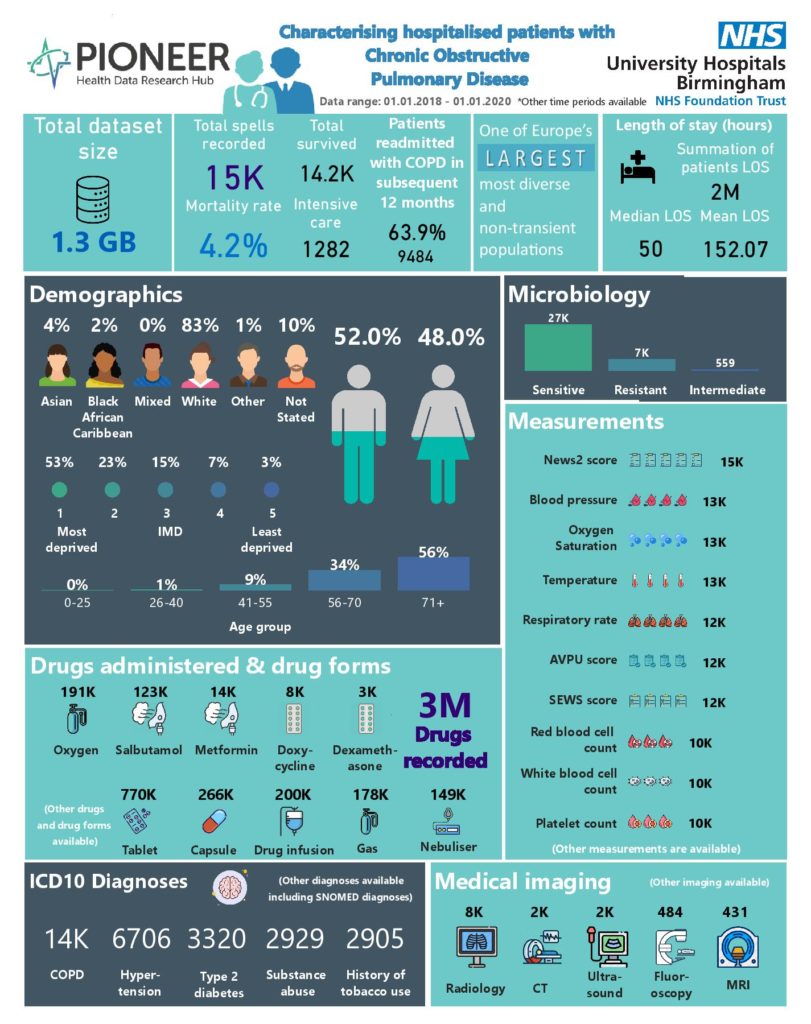- Introduction
- Data Coverage
- Further Details
- Request Access
Chronic respiratory diseases remain one of the leading causes of death from non-communicable disease, with the majority of deaths due to Chronic Obstructive Pulmonary Disease (COPD). COPD presents a significant healthcare burden and is detrimental to quality of life. Currently, there are no disease modifying treatments. Further to the burden of stable COPD, patients experience acute exacerbations (AECOPD), defined as an acute worsening of symptoms which requires a change in treatment. These are important events, associated with increased mortality, morbidity and long-term health impacts. Patients who exacerbate frequently are more likely to have a faster decline in lung function, have a lower quality of life and experience adverse cardiovascular event. Whilst there are therapies to reduce exacerbation frequency and treat the acute event, options have limited efficacy and have not changed in overall drug class for many years. Exacerbations are defined by the severity of the symptoms and the treatments involved – so a severe exacerbation is one which requires hospitalisation. However, in our ageing and increasingly frail population, hospitalisation can be required for even a minor event, if a person is already struggling to cope at home. 

PIONEER geography The West Midlands (WM) has a population of 5.9 million & includes a diverse ethnic & socio-economic mix. EHR UHB is one of the largest NHS Trusts in England, providing direct acute services & specialist care across four hospital sites, with 2.2 million patient episodes per year, 2750 beds & an expanded 250 ITU bed capacity during COVID. UHB runs a fully electronic healthcare record (EHR) (PICS; Birmingham Systems), a shared primary & secondary care record (Your Care Connected) & a patient portal “My Health”. Scope All hospitalised patients admitted to UHB between January 2018 to January 2020 curated to focus on COPD exacerbations. Longitudinal & individually linked, so that the preceding & subsequent health journey can be mapped & healthcare utilisation prior to & after admission understood. The dataset includes highly granular patient demographics & co-morbidities taken from ICD-10 & SNOMED-CT codes. Serial, structured data pertaining to acute care process (timings, staff grades, specialty review, wards), presenting complaint, acuity, all physiology readings (pulse, blood pressure, respiratory rate, oxygen saturations), all blood results, imaging reports, all prescribed & administered treatments (fluids, blood products, procedures), all outcomes. Available supplementary data Matched controls; ambulance, synthetic data, differing time periods including/excluding COVID-19 pandemic periods. Available supplementary support Analytics, Model build, validation & refinement; A.I.; Data partner support for ETL (extract, transform & load) process, Clinical expertise, Patient & end-user access, Purchaser access, Regulatory requirements, Data-driven trials, “fast screen” services.



